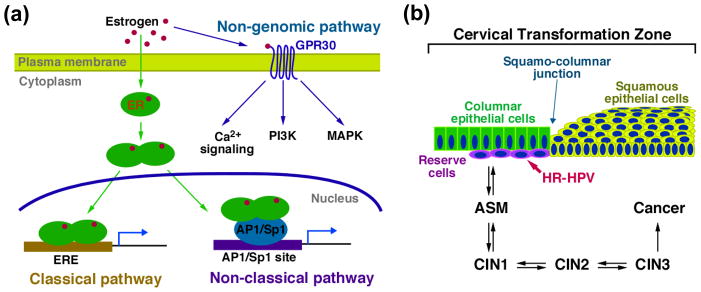Figure 1.
Estrogen pathway and cervical carcinogenesis. (a) Estrogen pathway. Estrogen binds to its cytosolic/nuclear receptors (ERα and ERβ) and membrane receptor GPR30 to exert its functions. Estrogen binds to ERs in the cytoplasm and induces ER homo- or hetero-dimerization. Estrogen-bound ERs then translocate to the nucleus, where they activate or repress target genes by two different mechanisms: classical pathway: ER binds to ERE and modulates target genes, and non-classical pathway: ER binds to AP1 or Sp1 transcription factors associated with their recognition sites in enhancer elements and modifies their function. Estrogen also binds to the membraneous receptor GPR30, a member of the G-protein coupled receptor family, and rapidly transduces various signaling pathways including but not limited to phosphatidyl inositol 3-kinase (PI3K), mitogen-activated protein kinase (MAPK), and Ca2+ signaling (non-genomic pathway). (b) Progressive disease leading to cervical cancer. It is believed that the multipotent reserve cells present in the transformation zone of the cervix are the progenitor cell type for cervical cancer. High-risk HPVs (HR-HPVs), such as HPV-16, infect and persist in these cells, and promote their aberrant squamous differentiation, which leads to atypical squamous metaplasia (ASM). ASM can progress to cervical intraepithelial neoplasia (CIN) grade 1–3 and eventually cervical cancer. This progressive neoplastic disease process normally takes over a decade following initial HPV infection before culminating in frank cancer. In most women, cervical disease spontaneously resolves prior to the development of cervical cancer.

